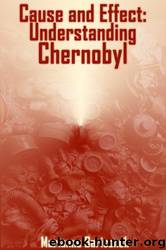Cause and Effect: Understanding Chernobyl by Marianne Barisonek

Author:Marianne Barisonek
Language: eng
Format: mobi
Tags: Europe, Russia, History
Published: 2011-03-21T22:00:00+00:00
Chapter 6: The Liquidators
“I lost the sensation in my left hand, later of the left arm, finally of half of my body. Later I suffered from palsy of the left arm, and now of both two legs. They did not know what to do, but they did not consider the radiation as a cause of my suffering. I still went working as trolleybus conductor, and I said nothing about my problems, because I needed an income for my family. I was driving the bus with one hand and one foot, until the day where I fell unconscious, and where they brought my home. Now I cannot walk, my legs are no more supporting my body, at home I have to lean against the wall. I was constantly falling, so my wife told me to remain in a rolling chair, where I am now. Nightmare! “The man is rotten, that’s all”. I have to resign. I am rather young, age 38, but one could say 60 years. His other colleagues had already died, so he concludes: “From the five friends we were, I remained the only one alive, like a white crow, an original.”
Anatoli Saragoviets from the film “The Sacrifice”
Somewhere between 600,000 and 800,000 people, mostly men, were sent to Chernobyl to deal with the aftermath of the disaster. The Soviets referred to the clean-up effort as “liquidating the consequences”. Chernobyl workers became known as liquidators. The term liquidator covers a wide variety of people from scientists and doctors to laborers. Some of the liquidators were in the army before the accident. Some were conscripted afterward in a special draft.
Under the Soviet system it wasn’t uncommon for people to be told that they would have to spend several weeks in another part of the country digging up potatoes, picking cotton or bringing in the rye harvest. So when Maluk Valechin was told that he had to report to the district headquarters he wasn’t particularly alarmed.
He’d heard rumors about something going on at the nuclear power station but no one knew any details. He was part of a convoy of over 100 trucks that went to the state-run farm not far from the reactor. They were to evacuate livestock.
Nothing seemed alarming until the veterinarian showed up wearing a rubber coat, heavy rubber gloves and boots. As they rode to farm the vet explained a little about radiation to Valechin. He told him that even though he wouldn’t be able to see anything, the radiation was very dangerous. He warned Valechin not to get out of the truck when they got to the farm.
Everything had to be done in a hurry. There were thousands of animals to evacuate. He couldn’t stay in the truck to keep away from some invisible radiation. He had to get out of the truck to load the cows and horses.
Everyone was outside in the dirt. The unusually hot, blustery weather blew up clouds of dust from the dirt road. Trucks and tractors, the frightened horses and cows; everything kicked up the dust.
Download
This site does not store any files on its server. We only index and link to content provided by other sites. Please contact the content providers to delete copyright contents if any and email us, we'll remove relevant links or contents immediately.
| Africa | Americas |
| Arctic & Antarctica | Asia |
| Australia & Oceania | Europe |
| Middle East | Russia |
| United States | World |
| Ancient Civilizations | Military |
| Historical Study & Educational Resources |
Red Famine: Stalin's War on Ukraine by Anne Applebaum(2816)
Chernobyl by Serhii Plokhy(2436)
Midnight in Chernobyl by Adam Higginbotham(2389)
The House of Government by Slezkine Yuri(2103)
Midnight in Chernobyl: The Untold Story of the World's Greatest Nuclear Disaster by Adam Higginbotham(2078)
Red Shambhala by Andrei Znamenski(2071)
The Gulag Archipelago (Vintage Classics) by Aleksandr Solzhenitsyn(1983)
All the Kremlin's Men by Mikhail Zygar(1961)
From Cold War to Hot Peace by Michael McFaul(1939)
Red Notice by Bill Browder(1927)
Putin's Labyrinth(1901)
The Future Is History by Masha Gessen(1820)
From Russia with Lunch by David Smiedt(1795)
A People's Tragedy by Orlando Figes(1766)
The Romanovs by Simon Sebag Montefiore(1722)
How to Tame a Fox (and Build a Dog): Visionary Scientists and a Siberian Tale of Jump-Started Evolution by Lee Alan Dugatkin & Lyudmila Trut(1680)
Putin's Labyrinth: Spies, Murder, and the Dark Heart of the New Russia(1664)
The Lost Spy by Andrew Meier(1634)
Art and Revolution by John Berger(1607)
